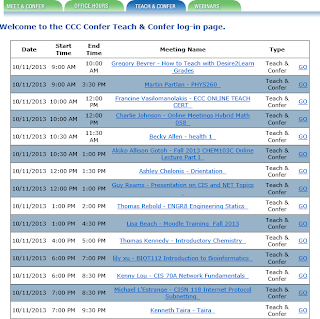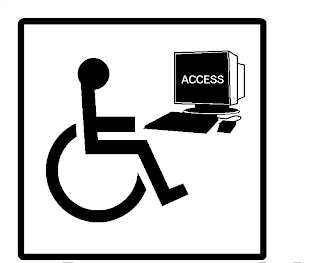 "Year's end is neither an end nor a beginning but a going on, with all the wisdom that experience can instill in us." - Hal Borland
"Year's end is neither an end nor a beginning but a going on, with all the wisdom that experience can instill in us." - Hal BorlandAnother year of Web conferencing in education has almost ended, and we've learned a lot from the many educators who use this technology to connect with students and colleagues around the world. Here's a sampling from the myriad posts, articles, and stories that added to our growing insights into the Confer classroom.
January: "Where the disabled are enabled" An inspiring story from Western University shows how hearing-impaired students in Martin Zinke-Allmang's "groundbreaking first-year Physics for the Life Sciences class" use Web conferencing - with the built-in closed captioning option - to get the class caption notes along with the PowerPoint slides of each lecture.
February: "40 Tips for Webinar Success" Ken Molay shared a free resource from AnyMeeting which you can still download here. As Ken says, "what is fun about the document is not the short reminders of steps to follow in planning, preparing, and producing a Webinar. They are nice little encapsulations of best practices. It’s the fact that each of the 40 tips includes a link to an article, blog post, or recording going into more detail on that subject."
March: "Reconsidering Online vs. In-Person Professional Meetings"Joshua Kim mused for Inside Higher Ed about the value of online meetings: "We travel to meetings for the people, not the content - and people are best experienced face-to face, not screen-to-screen.... We travel to professional meetings with the best of intentions of focusing on the event, and find ourselves pulled into putting out fires by e-mail and phone, working late into the night to stay on top of things.... Lately, I've been thinking that our understanding of how to plan and run a quality online professional meeting has advanced to the point where it makes sense to always consider this option when planning our own events."
April: "The Do's and Don'ts of Using Visuals in eLearning" Karla Gutierrez provides invaluable pointers for anyone trying to use visuals in an online class. "Images and visuals done incorrectly will cause harm rather than strengthen learning. But images incorporate and integrated into eLearning effectively, will bolster learning and lead to more student engagement and material retention." Karla practices what she preaches by using exemplary visuals and accompanying text.
May: "Blackboard Collaborate Brings Web Conferencing App to Android" T.H.E. Journal covered this significant milestone for Bb Collaborate: mobile Web conferencing for all major platforms (the iOS app was developed in 2012). "The new mobile version... allows users to participate in Collaborate conferences. Participants can chat, use two-way audio, use emoticons, answer survey questions, raise their hands, join breakout rooms, and view presentations, including annotations, images, shared applications, and shared desktops."
June: "A Case Study on the Adoption and Use of Synchronous Virtual Classrooms" From The Electronic Journal of e-Learning, this research article describes how faculty at the University of North Carolina (Wilmington) reacted to and adopted a Web conferencing application that was made available to them by the University. Survey data provided information on what influenced faculty adoption, and interview data described instructional approaches used by these adopters. A "subset of features led to ... adoption and are used frequently," while "perceived ease of use and usefulness of the technology may impel its use." Administrators trying to promote technology usage will find this case study useful and illuminating: it indicates the decision factors and features faculty consider when opting to use or ignore technology for instruction. "Based on the results of this case study, administrators can promote the factors and features that influence decision making to adopt the tool. Based on the interviews in this case study, administrators can also describe the ways how other faculty are using these tools in their classroom, and how beneficial it can be if adopted."
July: "Pasadena City College Classified Staff Demo of CCC Confer" and "DeAnza College Tutoring Program Presentation" In keeping with the theme of the June study (above), our June highlights include two presentations by colleges in the CCC system who describe how they use CCC Confer to accomplish teaching and meeting goals and objectives. The users are the best judges of a tool's usefulness, and these two demonstrations are user-produced and user-focused.
August: "3 Ways Webconferencing is Transforming PD" Another contribution from T.H.E. Journal describes "video learning communities" and "communities of practice" that self-generate when Web conferencing is used for professional development, connecting educators and making it possible for them to meet anytime and any place to share ideas and teaching practices.
September: "CCC Confer: Presenter Checklist" Another user-generated video from the College of the Redwoods designed to show fellow presenters how to prepare to use CCC Confer effectively.
October: "Ten Ways Web Conferencing Works in Education" Although this is a self-reflecting link, it's based on the excellent work of Beth Gallob, who is properly cited. Looking for ways to make the most of online technology? Here's a list of features you'll find it hard to ignore.
November: "Synchronous Learning: Is there a future?" Here's another academic study of adoption and innovation, using survey data to determine the thought processes of students who were exposed to instruction delivered via Web conferencing. "Eighty-two percent agreed or strongly agreed that [the technology] was 'easy to learn' and 73 percent stated it was 'easy to use.'... Seventy-three percent agreed or strongly agreed they would recommend [Web conferencing] to other persons for training, instruction, and learning. Only 31 percent of the students reported some technical problems during the three-hour session, and 55 percent reported no problems. More than 50 percent stated [the technology] was favorable or beneficial for their learning and 62 percent agreed or strongly agreed with the following, 'all things considered [Web conferencing] was a positive experience.' ”
December: "How Not to Look Ugly on a Webcam [Infographic]" If you spend a lot of time connecting to remote users and letting (or making) them see you from your Webcam, isn't it important to consider how to make that experience positive? This infographic considers lighting, background, bandwidth, noise level, what you're running on your computer, and positioning. It's easy to understand, and it will help to serve as a reminder.
The new mobile version of Collaborate for Android allows users to participate in Collaborate conferences. Participants can chat, use two-way audio, use emoticons, answer survey questions, raise their hands, join breakout rooms, and view presentations, including annotations, images, shared applications, and shared desktops.
Read more at http://thejournal.com/articles/2013/05/08/blackboard-brings-web-conferencing-app-to-android.aspx?=THE21#VcLODto0zA0xsB04.99
Read more at http://thejournal.com/articles/2013/05/08/blackboard-brings-web-conferencing-app-to-android.aspx?=THE21#VcLODto0zA0xsB04.99
Blackboard Brings Web Conferencing App to Android
Read more at http://thejournal.com/articles/2013/05/08/blackboard-brings-web-conferencing-app-to-android.aspx?=THE21#VcLODto0zA0xsB04.99
Read more at http://thejournal.com/articles/2013/05/08/blackboard-brings-web-conferencing-app-to-android.aspx?=THE21#VcLODto0zA0xsB04.99
Blackboard Brings Web Conferencing App to Android
Read more at http://thejournal.com/articles/2013/05/08/blackboard-brings-web-conferencing-app-to-android.aspx?=THE21#VcLODto0zA0xsB04.99
Read more at http://thejournal.com/articles/2013/05/08/blackboard-brings-web-conferencing-app-to-android.aspx?=THE21#VcLODto0zA0xsB04.99























